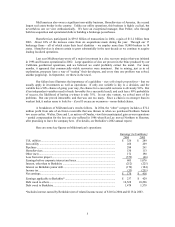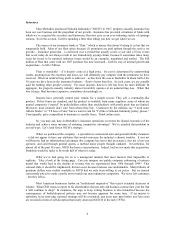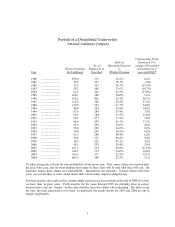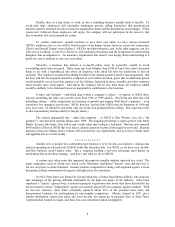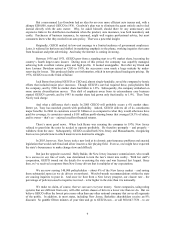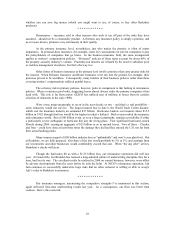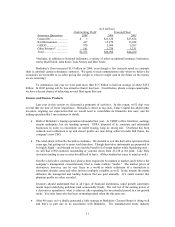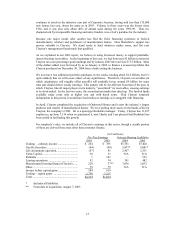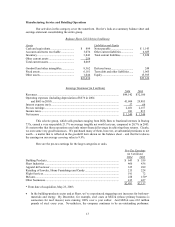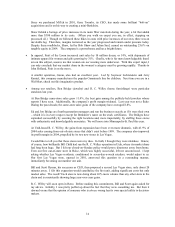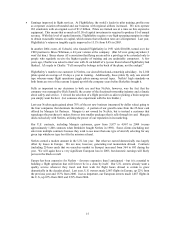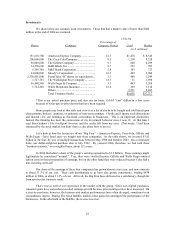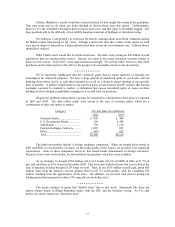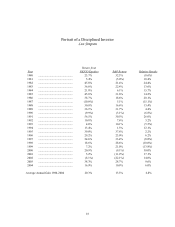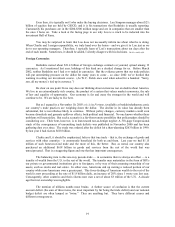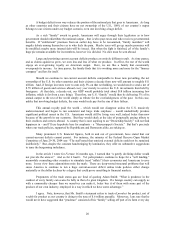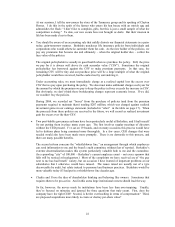Berkshire Hathaway 2004 Annual Report Download - page 16
Download and view the complete annual report
Please find page 16 of the 2004 Berkshire Hathaway annual report below. You can navigate through the pages in the report by either clicking on the pages listed below, or by using the keyword search tool below to find specific information within the annual report.• Earnings improved in flight services. At FlightSafety, the world’ s leader in pilot training, profits rose
as corporate aviation rebounded and our business with regional airlines increased. We now operate
283 simulators with an original cost of $1.2 billion. Pilots are trained one at a time on this expensive
equipment. This means that as much as $3.50 of capital investment is required to produce $1 of annual
revenue. With this level of capital intensity, FlightSafety requires very high operating margins in order
to obtain reasonable returns on capital, which means that utilization rates are all-important. Last year,
FlightSafety’ s return on tangible equity improved to 15.1% from 8.4% in 2003.
In another 2004 event, Al Ueltschi, who founded FlightSafety in 1951 with $10,000, turned over the
CEO position to Bruce Whitman, a 43-year veteran at the company. (But Al’ s not going anywhere; I
won’ t let him.) Bruce shares Al’ s conviction that flying an aircraft is a privilege to be extended only to
people who regularly receive the highest quality of training and are undeniably competent. A few
years ago, Charlie was asked to intervene with Al on behalf of a tycoon friend whom FlightSafety had
flunked. Al’ s reply to Charlie: “Tell your pal he belongs in the back of the plane, not the cockpit.”
FlightSafety’ s number one customer is NetJets, our aircraft fractional-ownership subsidiary. Its 2,100
pilots spend an average of 18 days a year in training. Additionally, these pilots fly only one aircraft
type whereas many flight operations juggle pilots among several types. NetJets’ high standards on
both fronts are two of the reasons I signed up with the company years before Berkshire bought it.
Fully as important in my decisions to both use and buy NetJets, however, was the fact that the
company was managed by Rich Santulli, the creator of the fractional-ownership industry and a fanatic
about safety and service. I viewed the selection of a flight provider as akin to picking a brain surgeon:
you simply want the best. (Let someone else experiment with the low bidder.)
Last year NetJets again gained about 70% of the net new business (measured by dollar value) going to
the four companies that dominate the industry. A portion of our growth came from the 25-hour card
offered by Marquis Jet Partners. Marquis is not owned by NetJets, but is instead a customer that
repackages the purchases it makes from us into smaller packages that it sells through its card. Marquis
deals exclusively with NetJets, utilizing the power of our reputation in its marketing.
Our U.S. contracts, including Marquis customers, grew from 3,877 to 4,967 in 2004 (versus
approximately 1,200 contracts when Berkshire bought NetJets in 1998). Some clients (including me)
enter into multiple contracts because they wish to use more than one type of aircraft, selecting for any
given trip whichever type best fits the mission at hand.
NetJets earned a modest amount in the U.S. last year. But what we earned domestically was largely
offset by losses in Europe. We are now, however, generating real momentum abroad. Contracts
(including 25-hour cards that we ourselves market in Europe) increased from 364 to 693 during the
year. We will again have a very significant European loss in 2005, but domestic earnings will likely
put us in the black overall.
Europe has been expensive for NetJets – far more expensive than I anticipated – but it is essential to
building a flight operation that will forever be in a class by itself. Our U.S. owners already want a
quality service wherever they travel and their wish for flight hours abroad is certain to grow
dramatically in the decades ahead. Last year, U.S. owners made 2,003 flights in Europe, up 22% from
the previous year and 137% from 2000. Just as important, our European owners made 1,067 flights in
the U.S., up 65% from 2003 and 239% from 2000.
15


